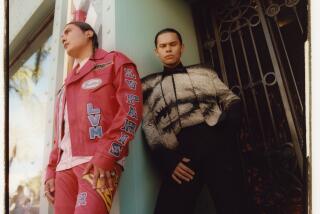PHOTO REVIEW : ‘Focus East’ Is Sometimes Posed, Often Extraordinary
- Share via
SAN DIEGO — Ah, the romance of the Middle East.
Four exotic-looking female “orange merchants” pose sensuously for the camera behind shallow wicker baskets laden with fruit. One woman, most of her face veiled, balances four plump oranges in a pyramid on her palm.
The image is redolent of a region that, despite violent strife, still resonates on many levels as a home of fabulous sheiks, Arabs on camels, seductive women, the biblical Holy Land and the seat of Western civilization.
This romantic image was even more pronounced in the Western world during the mid-19th Century, when a vogue in Middle Eastern culture erupted, especially in Europe. Fueled in part by countries such as France and Great Britain, which sought to expand their empires in the region, and by the engineering of the Suez Canal, attention focused on this portion of the world.
Scores of professional and amateur photographers descended to practice their new craft as governments commissioned surveys of the region, the people and its historic landmarks.
English, French, Italian, Spanish and German commercial photographers found a ready market in Europe for their images of the Middle East. Tourists also tried their hands at the bulky early cameras.
The Mideast afforded a proving ground for photography, which dates from 1839, as thousands of images were made to feed a ravenous hunger for information about this fabled land.
“Focus East: Early Photography in the Middle East, 1839-1885,” is a huge--even daunting--exhibition at the San Diego Museum of Photographic Arts that offers more than 200 images from this period.
The exhibit, organized by Nissan Perez, curator of photography for the Israel Museum in Jerusalem, opened at that museum in 1988. The extensive show offers many 19th-Century views of much of the Middle East.
We see boatloads of European visitors being rowed ashore, arriving in fancy carriages at a hotel, or “roughing it” in tents in the Holy Land.
Subjects range from religious sites such as the Jordan River, the Via Dolorosa and the Garden of Gethsemane, to Egyptian landmarks such as the Pyramid of Cheops and the myriad Mideast people.
One of the most beautiful of the pictures is titled “First Cataract of the Nile,” by Ottoman photographer J. Pascal Sebah. Sebah positioned his camera right at the river’s edge. Because the shutter speed was too slow to stop the action of the river, the image is of a blurred, foamy torrent flying over the rocky bed.
In researching the exhibition, Perez concluded that most of the European photographers romanticized the Middle East and that different nationalities portrayed the region differently. The images on view bear him out.
The English photographers had a more restrained view, maintaining a cool distance from Middle Easterners. The French concentrated on the romance of the region, and tended to set up photographs that fit with fictional literary accounts of the region. Those photographers who are near to or from the region, such as Sebah, gave a more accurate picture of the common people.
However, some key information about the images that Perez ferreted out during the six years he spent organizing the show is not on the walls but in a $50 book. For instance, he notes in the book that a man identified in an 1875 picture as the chief rabbi of Jerusalem is the same figure recorded by Frenchman Felix Bonfils as a common laborer. Bonfils and others, he said, resorted to models to give waiting Europeans the pictures they wanted.
Although a number of images by Italian and French photographers were supposedly captured “live,” such as the orange merchants by Italian Carlo Naya, they are actually posed tableaux vivants.
Nevertheless, the exhibit has many exquisite images. Armenian photographer G. Likegian captured the still beauty of a group of minarets. Louis de Clercq’s “View of the New Bridge” in Tripoli is a soothing inner-city landscape showing the comfortable arches of the bridge, the soft curve of the winding river and buildings stacked up a distant hill.
Considering the exhibit’s subject matter, its awesome size and Americans’ reportedly limited knowledge of geography, a couple of additions could aid the weary museum visitor. A large map of the Mideast, marking the names of the places photographed, would be helpful.
Benches to allow viewers to rest during their trek through the scores of photographs would be appreciated also. In the absence of places to sit in the museum, a suggestion: Viewers may wish to take a quick spin through the show to acclimate themselves, get a cup of coffee, think about what they have seen, then dive back in again.
“Focus East” continues through Sept. 10 at the Museum of Photographic Arts in Balboa Park.


